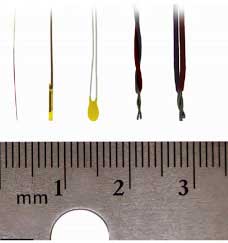Comparison of Temperature Sensors
The properties of materials and nearly all biological, chemical, and physical processes are temperature dependent. As a result, temperature is perhaps the most widely measured environmental variable, and there are multiple sensors, or thermometers, available to measure temperature. Some of the common thermometers for automated temperature measurement are:
Thermocouple:two different metals or alloys connected at the ends (see Figure 1 below) to from a simple electrical circuit (current loop). A temperature difference (thermal energy gradient) between the two ends of the circuit produces a voltage, called an electromotive force (emf), that is proportional to the temperature difference.
Thermistor:electrical resistor, often ceramic (see Figure 1 below), where resistance changes with temperature.
Platinum Resistance Thermometer (PRT):platinum coil, where resistance changes with temperature. Thermistors and PRTs are similar and operate via the same mechanism, but are made with different materials.
For temperature measurement with the thermometers listed, changes in the physical property (voltage, electrical resistance) related to temperature changes must be measurable, repeatable, and stable. These thermometers require a meter to make the electrical measurement and convert it to temperature. This is desirable for environmental monitoring, where many meters can log data, and automated data collection of high frequency and/or long-term data sets are often required. A summary table (Table 1) is provided to highlight the advantages and disadvantages of thermocouples and thermistors. The advantages and disadvantages of PRTs are similar to or the same as those for thermistors, except that the sensitivity (resistance change) in PRTs is much smaller and potentially more difficult to measure accurately.

Figure 1.热电偶的大小比较nd thermistors. From left to right: human hair (for scale), fine wire ceramic thermistor with thin epoxy coating, ceramic thermistor with epoxy bead coating, 30‐ AWG (0.2546 mm) type‐E thermocouple, and 24‐AWG (0.5106 mm) type‐E thermocouple. Thermocouple junctions are often coated with epoxy for electrical isolation and waterproofing, however, those in this picture are bare wires.
| Thermistor Advantages | Thermocouple Advantages |
| Reference temperature not required | Self-powered (no power required, no self-heating) |
| Large response (large output signal) | Simple datalogger program |
| Rugged, inexpensive wire | |
| Single-ended channel | |
| Thermistor Disadvantages | Thermocouple Disadvantages |
| Require power | Require accurate reference temperature |
| Self-heating errors from applied power | Small response (small output signal) |
| Multiple datalogger program steps | Expensive wire |
| Differential channel |
Table 1.Advantages and Disadvantages of Thermistors and Thermocouples
列出的一些优点和缺点Table 1 are dependent on the circumstances of the specific measurement and application. Multiple datalogger program steps for many thermistors are avoided with dataloggers that have ‘canned’ thermistor instructions. A ‘canned’ instruction is a set of pre‐programmed datalogger codes that allow use of specific sensors with only a single instruction. Also, the power requirement of thermistors is extremely small. For example, a commonly used thermistor in environmental applications only uses 0.056 mW at 20 C. The maximum current draw across a wide range of temperatures is approximately 0.090 mA. A commonly used datalogger can source 25 mA. Based on this specification, the datalogger could accommodate over 250 thermistors if there were enough measurement channels available.
The reference temperature required for thermocouples is available on many dataloggers. Accurate reference temperature measurements are then dependent on the accuracy of the sensor used to measure it. This is often a thermistor. Periodic recalibration of the datalogger is recommended to ensure the thermistor is accurate. Also, the datalogger wiring panel (where the thermocouples are connected) should be kept isothermal. This is best accomplished by installing the logger in an insulated, weatherproof box that shields the logger from solar radiation. The small output signal of a thermocouple relative to the large output signal of a thermistor is only a disadvantage when a low resolution datalogger is used to make measurements. Some dataloggers have adequate resolution to make highly accurate thermocouple measurements. The datalogger program required for thermocouples is only simple because it is generally always available as a ‘canned’ instruction. If thermistor and thermocouple datalogger programs had to be written from scratch, the number of program steps and the difficulty level would be similar. Because thermocouples require a differential channel and thermistors do not, this is always a disadvantage. This means twice as many thermistors can be connected to the same number of datalogger channels
